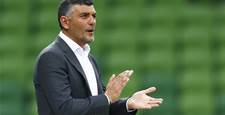I thought I'd use this blog to talk you through a typical session I would run for my 12 year olds and let you download the session plan.
We always try to always cover the same key elements in each session.
Warm up
Ball Mastery
Technique work
Speed work
Session Topic - throughout the 30 weeks of the program we systematically work through a number of set topics such as 1v1 attacking and defending, passing & receiving etc etc
In the session plan here my topic was shooting.
Game - we always finish with an 8 v 8 game where we try to ensure the players put that night's session topic into play in the game environment and where necessary we will manipulate the conditions we put on the game to facilitate this.
I'll give you a quick walk through this session.
1. Warm up - we always start with range of dynamic stretching working in a line to two markers 20m apart. Towards the end of the program we tried something different and got one of the lads to lead the warm up each week to start the session. This worked surprisingly well on a few counts....it provided a bit more self policing...as sometimes 12 yr old boys can deliberately try your patience and take a while to settle down at the start of a session, with one of their own in charge for 5 minutes it seemed to switch them on quicker, it was good practise for the lad running the warm up - at this age communication on the pitch and having the confidence in delivering that communication is generally a bit lacking and this was a great way to get them used to commanding and organising their team mates. It showed them how frustrating it can be when we want to start a session and they are a bit reluctant to listen....gives them a sense of what have to put up with. In short this worked well and I will introduce this earlier in the program next year as soon as the kids are familiar with the elements of the warm up. We also encouraged the kids to come up with a warm up exercise of their own on the fly which tested their initiative and rewards it with 15 of their peers then performing the exercise on their command.
2. Dribble on demand - within a confined area the kids have a ball each and begin to dribble at normal pace. At regular intervals they have to respond to my command and do as I say such as go faster, go slower, turn, stop flick the ball and up and keep it up until I say go again, use their strongest foot, then their weakest foot only, perform a skill move (step over, feint) ...if I shout swap balls they have to stop their ball dead...leave their ball behind and take control of another players. Having 16 players in a confined space means they have to get their head up to avoid collisions. I also introduced a game element towards the end of this exercise where every time I told them to leave their ball behind I removed one ball from the area so one kid was left without a ball who then dropped out in a musical chairs like game. You can sometimes forget that they are still quite young kids and just a simple game like this can really help focus them and help you get the outcome you're looking for - in this case scanning their environment to see where the free balls are then reacting quickly to get there ahead of the other boys
3. Target practise - we do a lot of work each week on the kids control and touch and basic technique development. Again to make it fun for the kids and to focus them on the task we split them into two teams and make a game of it. The kids are single file in two teams and about 5 yards in front of them are 3 balls perched on 3 cones...behind the balls/cones is the coach who has a supply of balls. The coach serves the ball to the first player in the line who has to try to knock one of the balls off the cones and then join the back of the queue. Each game has a different technique the players has to use - starting with head, then a side footb volley with right foot, then left foot, then a control on the thigh and volley then finish with chest control and volley. They keep going until the winning team is the first to knock all three cones off. The winners choose a forfeit for the losers of 10 press ups, sit ups or squat thrusts. This kids love the competitive element which helps focus them on not just the technique in isolation but then the control to then direct the ball to a defined target
4. Speed work - occasionally we will do the odd bit of foot speed work without a ball but for no more than 10 minutes. Here I set up two mannequins and two poles to form a finishing gate around 10-15m away from the mannequins. Again in two teams the boys take it in turns to come forward and stand immediately behind the mannequin with the mannequin between themselves and the finish line. They have their backs to the finish line and jog on the spot. The coach then shouts "left" or "right" at which point the players have to turn around that direction and then sprint through the gate to beat their opposite number. The head to head competitive element creates the desired intensity, the response to a specific instruction develops their reaction times and the need to avoid the mannequin creates a degree of realism as they can always turn and run in a straight line on the pitch.
5. Shooting exercise 1 - near post power or far post curl
Working from both sides of the goal alternately in two groups....the player working plays the ball into the coach who then rolls it into a shooting position for the player to make an arced run to strike on goal. The player has a choice of going for the near post with power low and hard or far post curl. We place two mannequins on the goal line to create a target for the players to aim for between the mannequin and the post. Players work from both sides to work both feet. Start by allowing them a touch to set themselves for the strike and then move to first time strike
6. Shooting exercise two - two strikes on goal...one on the run and then one first time
I'm a big fan of exercise that makes players work twice in short succession as it creates a level of intensity closer to game conditions and works both technique execution and reaction speeds and two executions in quick succession varies things so the exercise feels less routine.
In this instance I've set up two mannequins about 10 yards apart just outside the 18 yard box. The player working begins by dribbling directly towards a mannequin before beating the mannequin with a skill move (step over/feint) moving into the box and striking for the corners (two mannequins still on the goal line providing targets to aim for). As soon as the lad gets his first shot away he has to get back on side between the two mannequins outside the box as soon as he's on side the coach rolls a second ball back into the area which the player then has to hit first time. You can vary this deliver of the second ball to be a bouncing ball if you want to work on volleying.
It's quick, sharp, game realistic (the need to get back on side) and works two different shooting techniques - striking the ball on the run from the edge of/just inside the box and a sharp, first time reaction strike from inside the box.
7. With the 8 v 8 game to finish we will put the mannequins inside the posts and only count goals scored in the corners to help focus on the execution of what we've been working on in the game situation.
So there you go...that's a standard session we would run for 16 twelves year old kids of above average ability.
You can see the structure of my session with the individual elements and the specific exercises I ran on this particular night.
Feel free to let me know your thoughts.












